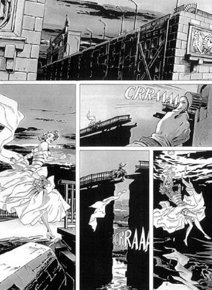The French and Belgians love a good bande dessinée (comic book), or, as they’re known more affectionately, “BD.” Historically, the authors and illustrators of their comics have been ahead of the trend in garnering respect for their craft; you could say Francophone comics have long been embraced as a serious form of artistic expression. Even the French phrase for comic book translate to “the drawn strip,” evoking an almost cinematic definition for something the English speaking world pegs as “comic.”
It was with this understanding of comic books that the French graphic novelist Pierre Christin sought to discover what a good “BD” can say about death. “[Death] has become something of “commercial value” for the media,” says Christin, who has faith in the idea of finding an enlightening perspective on death in comic books:
“Occultée parfois, crainte le plus souvent, la mort est un thème récurrent dans l’art et sa représentation évolue en même temps que les croyances et les sociétés”
(Sometimes overshadowed, feared the most often, death is a recurring theme in art and its representation evolves in tandem with [our] beliefs and societies).
In an online lecture for the University of Bordeaux, Christin discusses the significance of death in his science-fiction comic book/graphic novel Valériane. First published in the 1967, Valériane constantly explores “dreams and ironic visions of death through many characters,” as well as the tendancy for death and disappearance to become synonymous in BDs.
What is it about the comic book format that permits Christin to play with perceptions of death so powerfully? Firstly, there’s the role a comic book’s “cells” (gridded images) play for a BD’s characters. A cell creates a literal and metaphorical boundary for its inhabitants, forever designating them to snapshots of both real and imagined scenarios. So, if a character dies in a cell – and we choose to dwell on that cell – then they remain dead. Yet, the second we continue reading, we re-introduce possibilities of life to the plot. In short, Christin says that we can alter the reality of death with as much ease as turning back a page.
Reading also becomes an insufficient verb to describe what one does with a comic book; we are more so consuming a combination of writing, color and composition in a way that echoes our own, often unconscious feelings in relation to death. Thus, when Christin’s “characters fall, die, or simply disappear from the page” it is with a resonance that we provide them with. “It depends,” he says, “on the duration of our gaze.”
Finally, Christin explains that one of his most powerful tools in communicating death to a reader is through the absence of action in a cell. “What’s here?” he says in his video-lecture, pointing to another graphic artist and collaborator’s cartoon of Auschwitz, “it’s not someone dying. It’s the depiction of death through its very absence.” He compares the drawing’s style that of classical painting, pointing out that the two share a concept of absence as one of the most fearful aspects of death (consider Arnold Böcklin’s 1886 paintng, “Isle of the Dead”). It’s the realization, he says, “that what’s most powerful about death is this idea of having nothing. Of disappearing.”
Would you be interested in reading a graphic novel or comic book that helps you reflect on death? We look forward to your comments below.
Related:
- Watch Chistin’s University of Bordeaux lecture here (note: it’s in French).
- Visit the official site of Pierre Christin
- Read SevenPonds’s post on the photography of ex-pat Lee Miller

 Pierre Christin on Images of Death in Comics
Pierre Christin on Images of Death in Comics





 Forest Bathing Eases Grief by Soaking in Nature
Forest Bathing Eases Grief by Soaking in Nature
 The Spiritual Symbolism of Cardinals
The Spiritual Symbolism of Cardinals
 Meaning-Focused Grief Therapy: Imaginal Dialogues with the Deceased
Meaning-Focused Grief Therapy: Imaginal Dialogues with the Deceased















Spot on with this write-up, I truly think this web site needs a great deal more
attention. I’ll probably be back again to see more, thanks for the information!
Report this comment